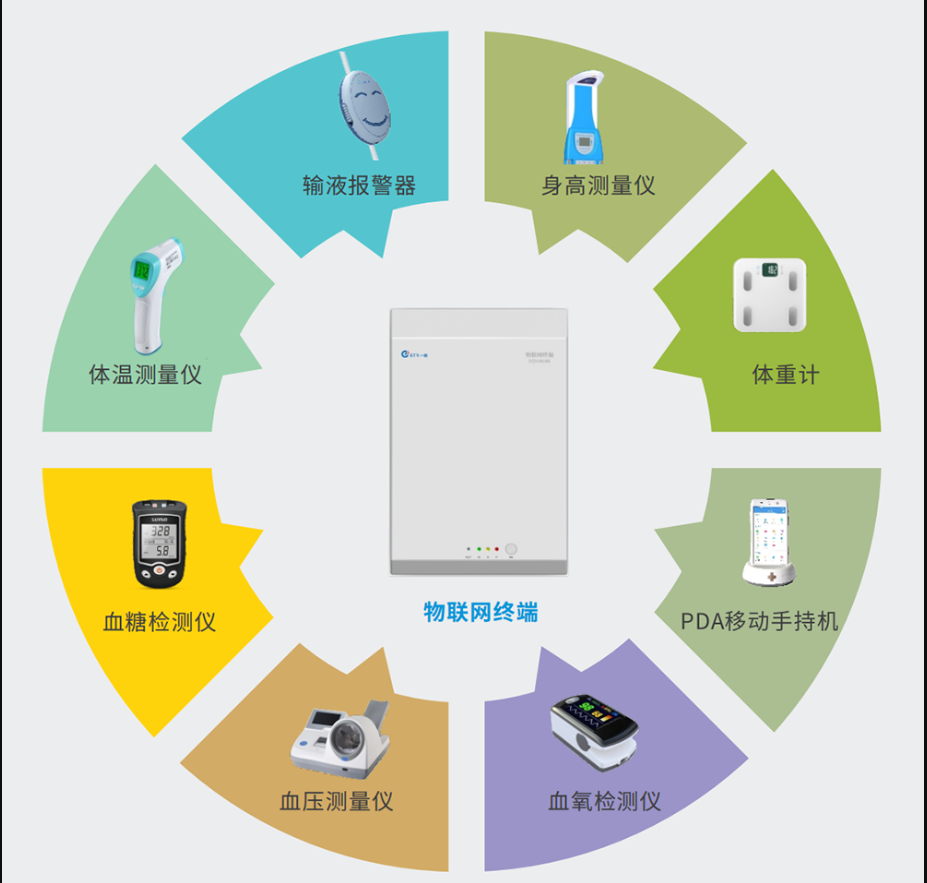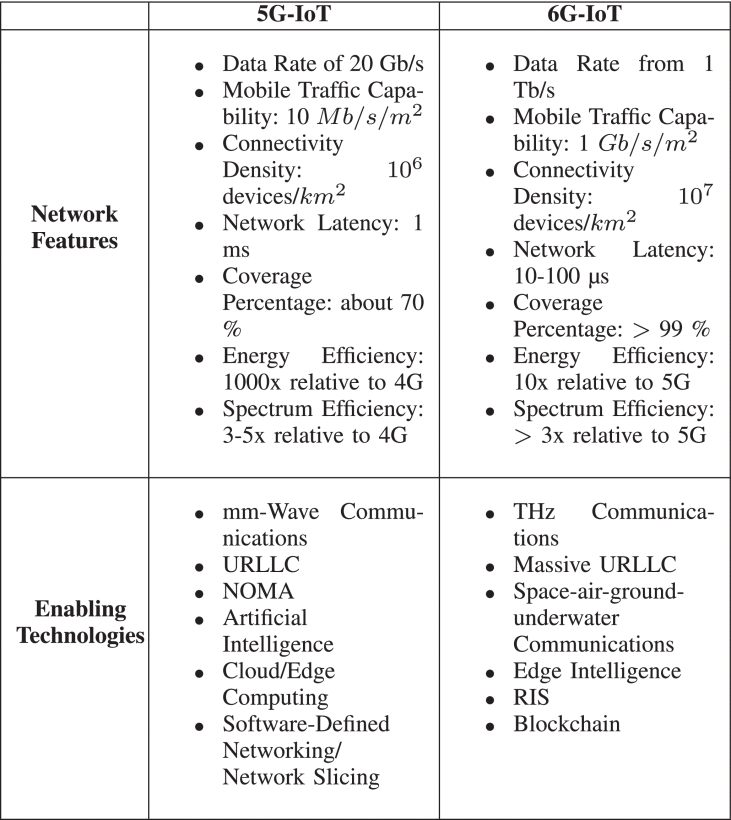随着科技的不断进步,第六代移动通信技术(6G)已成为未来通信领域的研究热点之一。另一方面,在医疗领域,物联网技术的应用正在迅速发展。为给物联网及其他领域的发展铺平道路,“第六代(6G)无线网络及其相关技术趋势的研究近年来受到学术界和工业界的广泛关注。”[2]
"目前,学界主要聚焦于探讨6G在潜在物联网中的广泛应用,主要包括医疗物联网、车载物联网与自动驾驶、无人机、卫星物联网以及工业物联网几个方面。”[3]值得关注的是,6G与物联网的结合将进一步推动医疗物联网的发展,有助于大大提高医疗水平、效率、普及程度,以及人民的健康水平和福祉。本文将主要选取6G与物联网中的相关研究论文进行翻译,期望以较为浅显易懂的语言向大众普及6G与物联网相关的知识。我们将试图探讨6G技术在物联网网络和应用中带来的新兴机遇以及挑战,从而更好地将6G和医疗物联网相结合,为人民创造更大的福祉。
01
6G for Healthcare Internet of Things
用于医疗保健物联网的 6G
The integration of 6G will revolutionize HIoT by using its enabling technologies. The work in a paper discussed the potential use of 6G technologies, such as mURLLC and THz communications for supporting extremely low-latency healthcare data transmission and accelerating medical network connections between wearables and remote doctors.
应用6G技术后,6G 的融合将彻底改变医疗物联网。我们参考的文献对6G 技术的潜在应用进行了讨论,如运用巨型超可靠低延时通信(mURLLC) 和太赫兹通信支持极低延迟的医疗数据传输,以及为可穿戴设备与远程医生之间的医疗网络连接提速。
事实上,在医疗保健领域(如远程健康监测),有低延迟通信(低于 1 毫秒)和高于 99.999% 的可靠性要求,以实现近乎实时的健康服务和快速可靠的远程诊断。有趣的是,“6G 机器人技术可应用于远程手术,远程医生可通过机器人系统为病人进行手术,延迟时间仅为毫秒,可靠性高。”[4]
To solve the slow healthcare response rates, UAVs are employed as relays to transport light-weight healthcare items, such as medicines and surgical tools among hospitals in emergent situations, which helps avoid road-traffic congestions and, thus, mitigates data exchange latency. Meanwhile, to achieve future requirements in terms of ultrahigh data rates of medical data communications, the mURLLC technology is an ideal solution by using the THz bands in 6G-based healthcare networks.
为解决医疗响应速度慢的问题,无人机充当继电器,负责在紧急情况下穿梭于各医院运送药品和手术工具等轻型医疗物品;这能避免道路交通拥挤,从而减少数据交换延迟。同时,mURLLC 技术基于 6G医疗网络,使用太赫兹频段,能完美实现未来医疗数据通信对于超高数据速率的要求。
由此,纳米设备、植入物和体外传感器可以与边缘设备或云中心进行实时通信和传输数据,用于短期和长期医疗分析,并具有极高的可靠性和适配性。特别是,mURLLC 在医院远程治疗中也发挥着关键作用,医生可以利用由 6G 核心网络互联的医疗机器人和辅助设备提供的实时视频直播,远程监控和管理手术过程。
此外,基于 6G 的 URLLC 已被用于加速未来医疗互联救护车的数据传输。这种救护车可以以中等速度(高达 100 公里/小时)向医院的临床医生和医务人员发送具有高彩色分辨率的实时视频直播,帮助做出正确诊断。例如,临床检查的脑电图数据可在救护车上进行,通过基于URLLC的实时远程会诊,医院医生能够对救护车上的医务人员进行紧急指示。在这种情况下,虽然救护车可以高速行驶,但极短存活时间(低于 2 毫秒)同样可以保证。
图片源自Microsoft Bing
02
Research Challenges and Future Directions
研究挑战与未来方向
我们将重点介绍几个有趣的研究挑战,并指出 6G+物联网未来可能的发展方向。
1. Security and Privacy in 6G-IoT
6G+物联网的安全与隐私问题
the integration of 6G into IoT networks may be vulnerable to threats related to wireless interface attacks, such as unauthorized access to data at computing units/servers, threats to integrity in the access network infrastructure, and Denial of Service (DoS) to software and data centers .
6G 与物联网的结合可能容易受到有关无线接口攻击的威胁,如未经授权访问计算单元/服务器上的数据、威胁接入网络基础设施的完整性以及拒绝为软件和数据中心服务。
2. Energy Efficiency in 6G-IoT
6G+物联网的能源效率
In future 6G-based IoT networks, how to achieve high energy efficiency is a major concern. The data communications and service delivery services, e.g., vehicular data sharing in autonomous driving, packet delivery in the space with UAV communications, requires significant energy resources to ensure the network operations.
在未来基于 6G 的物联网网络中,如何实现高效能是一个重要问题。数据通信和服务交付服务,如自动驾驶中的车辆数据共享、无人机通信中的空间数据包交付等,都需要大量的能源资源以确保网络运行。
3. Hardware Constraints of IoT Devices
6G+物联网受硬件限制
The hardware constraint of IoT devices is another possible challenge in communications and computations 6G-based IoT networks. For example, in intelligent 6G-based healthcare, wearable sensors and mobile devices should be able to simultaneously run AI functions to achieve edge intelligence and implement data transmission with URLLC. Due to the constraints of hardware, memory, and power resources, certain IoT sensors cannot meet the corresponding computational requirements.
物联网设备的硬件限制是基于 6G 的物联网网络在通信和计算方面可能面临的另一挑战。例如,在基于6G的智能医疗中,可穿戴传感器和移动设备应能同时运行人工智能功能以实现边缘智能,并通过 URLLC 实现数据传输。由于硬件、内存和电力资源的限制,某些物联网传感器无法满足相应的计算要求。
4. Standard Specifications for 6G-IoT
6G+物联网标准规范
The emergence of 6G technologies potentially transforms the shape of IoT markets and revolutionizes the IoT ecosystems with advanced wireless networking features. However, the development of 6G-IoT systems requires stringent standard specifications that calls the collaboration of all business stakeholders, such as network operators, services providers, and customers. The lack of system standards can hinder the deployment of 6G functions and technologies in customer IoT systems.
6G 技术的出现有可能改变物联网市场的形态,并利用先进的无线网络功能彻底改变物联网生态系统。然而,6G+物联网系统的开发需要严格的标准规范,需网络运营商、服务提供商和客户等所有商业利益相关者的通力合作。缺乏系统标准会阻碍客户物联网系统中运行的 6G 功能和技术。
下图将对比5G和6G网络环境下的物联网特征,帮助读者加深理解。

图源自论文6G Internet of Things: A Comprehensive Survey | IEEE
Research on 6G-IoT networks and applications is still in its infancy. This being said, it is envisioned that 6G will transform the current IoT network infrastructures and bring new levels of service quality and user experience in the future applications. We believe our timely work will shed valuable light on the research of the 6G-IoT integration topics as well as motivate researchers and stakeholders to augment the research efforts in this promising area.
有关 6G 物联网网络和应用的研究仍处于萌芽阶段。尽管如此,可以想象的是,6G 将改变当前的物联网网络基础设施,并在未来的应用中将服务质量和用户体验提升到新高度。我们相信,我们抓住时机,及时行动,将会让6G+物联网集成课题的研究受惠,并激励研究人员和利益相关者更有动力研究这一前景广阔的领域。